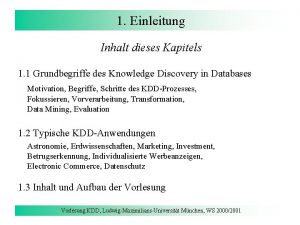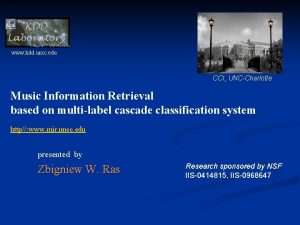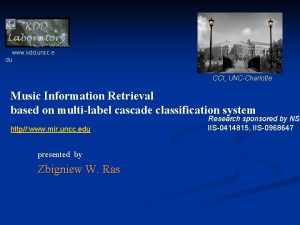www kdd uncc edu College of Computing and












- Slides: 12

www. kdd. uncc. edu College of Computing and Informatics University of North Carolina, Charlotte RSES – reducts and discretization of attributes presented by Zbigniew W. Ras University of North Carolina, Charlotte, NC & Polish-Japanese Academy of Information Technology, Poland


Information System REDUCTS a b c d f x 1 x 2 0 0 L R 0 1 L L 0 1 x 3 x 4 0 0 L R 0 1 L L 0 1 x 5 1 R 0 L 2 x 6 1 R 0 L 2 x 7 2 S 2 H 3 x 8 2 S 2 H 3 Discernibility Matrix x 1 x 2 x 3 x 4 x 5 x 6 x 7 x 8 bc bc ab ac abcd abcd abcd x 1 x 2 x 3 x 4 x 5 x 6 x 7 x 8 Discernibility Function: f(a, b, c, d) = (b + c) (a + b + c + d) (a + c) =(b + c) (a + b) (a + c) = (ba + bb + ca + cb) (a + c) = (b + ca) (a + c) ba + bc + ca (b=L) (f=0); (a=0)*(b=R) (f=1); Reducts: {b, a}, {c, b} ……


(b+c+d)b(a+b+c+d)(b+c)(b+d)(a+b+c)(a+b)(c+d) = bc + bd





Discretization of numerical attributes X x 1 x 2 x 3 x 4 x 5 x 6 x 7 a 0. 8 1 1. 3 1. 4 1. 6 1. 3 b 2 0. 5 3 1 2 3 1 d 1 0 0 1 1 Va = [0, 2), Vb = [0, 4) p 1 p 2 p 3 p 4 Dom(a) = {0. 8, 1, 1. 3, 1. 4, 1. 6}, G(x 1, x 2)=p 1+q 2 G(x 1, x 3)=p 1+p 2+q 3 G(x 1, x 5)=p 1+p 2+p 3 G(x 2, x 4)=p 2+p 3+q 1 G(x 2, x 6)=p 2+p 3+p 4+q 1+q 2+q 3 G(x 2, x 7)=p 2+q 1 G(x 3, x 4)=p 3+q 2+q 3 G(x 3, x 6)=p 3+p 4 G(x 3, x 7)=q 2+q 3 G(x 4, x 5)=q 2 G(x 5, x 6)=p 4+q 3 G(x 5, x 7)=p 3+q 2 x 1, x 3 x 1, x 5 x 2, x 4 x 2, x 7 x 3, x 6 x 5, x 6 q 1 q 2 q 3 Dom(b) = {0. 5, 1, 2, 3} P 1 P 2 1 1 P 3 P 4 Q 1 Q 2 Q 3 1 1 1 1

(x 1, x 2) (x 1, x 3) (x 1, x 5) (x 4, x 2) (x 4, x 3) (x 4, x 5) (x 6, x 2) (x 6, x 3) (x 6, x 5) (x 7, x 2) (x 7, x 3) (x 7, x 5) new p(1, a) 1 1 1 0 0 0 0 0 p(2, a) 0 1 1 1 0 0 0 p(3, a) 0 0 1 1 1 0 0 0 1 0 p(4, a) 0 0 0 1 1 1 0 0 p(1, b) 1 0 0 0 p(2, b) 1 0 0 0 1 1 0 p(3, b) 0 1 0 1 0 1 0 0 d* 1 1 1 0 Step 1. Choose a column from B with the maximal number of occurrences of 1’s. Step 2. Delete from B the column chosen in Step 2 and all rows marked in this column by 1. Step 3. If B is non-empty go to step 2 else Stop.

Questions? Thank You





















